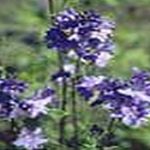| Common Name: |
American Greek Valerian |
| Genus: |
Polemonium |
| Family: |
Polemoniaceae |
| Botanical Name: |
Polemonium reptans |
| Other Names: |
Abscess Root, False Jacob's Ladder, Greek Valerian, Sweet Root |
| History |
A genus of 25 species of rhizomatous and clump-forming perennials, and spreading annuals, often with unpleasant-smelling foliage. They occur in temperate regions of the northern hemisphere, mainly in N. America, but also in southern S. America, and Asia. Most have blue or white saucer-shaped flowers. Polemonium caeruleum is a variable species, widely grown in borders and wild flower meadows. The less vigorous P. reptans is also popular as a border perennial, with cultivars in shades of blue and pink. Both P. caeruleum and P. reptans are often called "Greek Valerian", though they are not related to true valerian (Valeriana officianalis) and havequite different medicinal properties. The plants do, however attract cats, which roll in them with evident pleasure. In ancient Greek times P. caeruleum was prescribed in wine for dysentary, toothache, and poisonous bites. It passed into various European pharmacopoeias as herba varlerianae graeca, and was used mainly for rabies and syphilis. Being ornamental and easily grown, P. caeruleum and P. reptans are often planted in herb gardens, though they are seldom used for medicinal purposes today. |
| Cultivation |
Moist soil in sun or partial shade. Polemonium caeruleum tolerates alkaline conditions: P. reptans prefers rich soil. Cut back flower stems to base after flowering, unless seed is required. |
| Propagation |
By seed sown in autumn or spring: by division in spring. Cultivars may not come true from seed. P. caeruleum may self-seed excessively in optimum conditions. |
| Harvest |
Plants (P. caeruleum) are cut in summer for infusionss. Rhizomes (P. reptans) are lifted in winter and dried for decoctions and tinctures. |
| Hardiness |
Z3 - 9 |
| Height: |
15-30cm (6-12in) |
| Width: |
30cm (12in) |
| Variants: |
Pink Dawn
Has pale pink flowers. |
Virginia White
syn. Album
Has white Flowers. |
|
| Properties |
A slightly bitter, acrid, astringent herb that increases perspiration, and has expectorant and alterative effects. |
| Medicinal Uses: |
This herb has several different medicinal uses. Due to it's ability to stimulate several glands it can be used to induce perspiration. It has been reccommended for use for lung diseases, and bronchial disturbances,especially in in the case of high fevers resulting from same.
Astringent, alterative, diaphoretic, expectorant. This plant has been recommended for use in febrile and inflammatory eases, all scrofulous diseases, in bowel complaints requiring an astringent, for the bites of venomous snakes and insects, for bronchitis and laryngitis and whenever an alterative is required. It has been used in the past to cure consumption.
Internally for cough, colds, bronchitis, laryngitis, tuberculosis, feverish and inflammatory conditions, including skin diseases and poisonous bites. Rarely used today.
|
| Preparation and Dosage: |
Place 1oz. of this herb into a 1pt. of boiling water and allow to cool to drinking temperature. Take ½c. at a time BID or TID as needed. Discontinue use once fever has broken.
|
| Parts Used: |
Root, Rhizome |
| Location: |
This plant grows from New York to Wisconsin, in woods, damp grounds, and along shady river-banks. |
| Classification: |
Herb |
| Bibliography: |
"Encyclopedia of Medicinal Herbs" Joseph Kadans ~ ©1975 Arco Publishing Co. Inc.~pg 17.
botanical.org - A Modern Herbal
all-creatures.org
Art and Photo Journals and Galleries Directory
Encyclopedia or Herbs ~ Demi Brown ~ ©2005 Dorling Kindersley Limited ~ pps. 325 - 326
|
